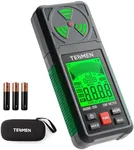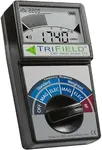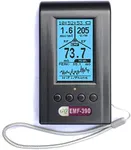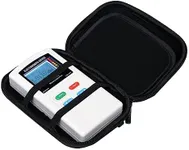Buying Guide for the Best Emf Meters
Choosing the right EMF (Electromagnetic Field) meter can feel overwhelming, but understanding your needs and the key features will help you make a smart decision. EMF meters are used to detect and measure electromagnetic fields, which can come from household appliances, power lines, or wireless devices. Before buying, think about what you want to measure—are you concerned about general household EMF exposure, or do you need to check for specific sources like Wi-Fi or electrical wiring? Knowing your purpose will help you focus on the most important features and avoid paying for unnecessary extras.Type of EMF DetectedEMF meters can detect different types of electromagnetic fields: electric fields, magnetic fields, and radiofrequency (RF) fields. Some meters only measure one type, while others can measure two or all three. If you are mainly concerned about power lines or household wiring, a meter that measures magnetic and electric fields is important. If you want to check for wireless devices like Wi-Fi routers or cell phones, make sure the meter can detect RF fields. Choose a meter that matches the sources you are most concerned about.
Frequency RangeThe frequency range tells you what kinds of EMF sources the meter can detect. Lower frequencies are usually from electrical wiring and appliances, while higher frequencies come from wireless devices. Meters with a wide frequency range can detect more types of EMF, but if you only care about one kind (like Wi-Fi), you can focus on meters that cover that specific range. Think about the sources in your environment and pick a meter that covers those frequencies.
Sensitivity and AccuracySensitivity is how small a field the meter can detect, and accuracy is how close the readings are to the real value. Higher sensitivity and accuracy are important if you want detailed measurements or are concerned about low-level exposure. For general home use, moderate sensitivity is usually enough. If you need professional or scientific results, look for higher accuracy and sensitivity. Your need for precision should guide your choice here.
Display and ReadoutThe display shows you the EMF readings, and it can be digital or analog. A clear, easy-to-read display makes it simpler to understand your results. Some meters also have features like backlighting or sound alerts. If you plan to use the meter in different lighting conditions or want quick feedback, look for these features. Choose a display style that feels comfortable and easy for you to use.
Ease of UseSome EMF meters are simple with just a few buttons, while others have more complex settings and options. If you are new to EMF measurement, a straightforward meter is best. If you want to do more detailed analysis, you might prefer a meter with more features. Think about your experience level and how much time you want to spend learning to use the device.
Portability and Build QualityPortability refers to how easy it is to carry the meter around. Smaller, lightweight meters are easier to use in different locations. Build quality is about how sturdy and durable the meter feels. If you plan to use the meter often or take it to different places, look for a portable and well-built model. If it will mostly stay in one spot, size and weight may be less important.
















